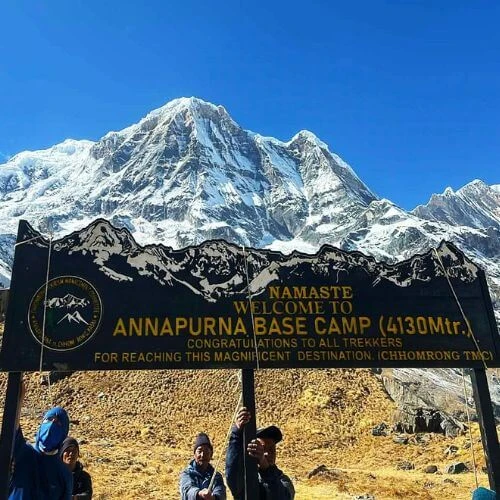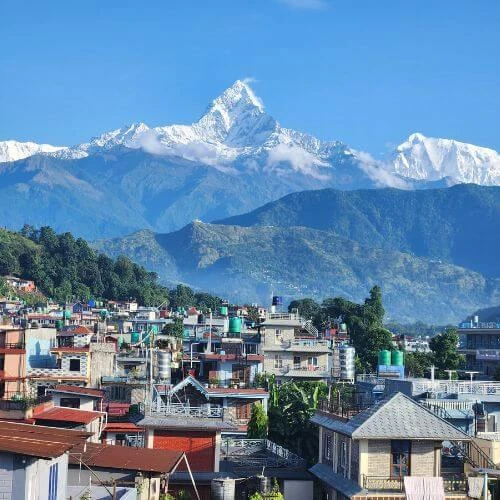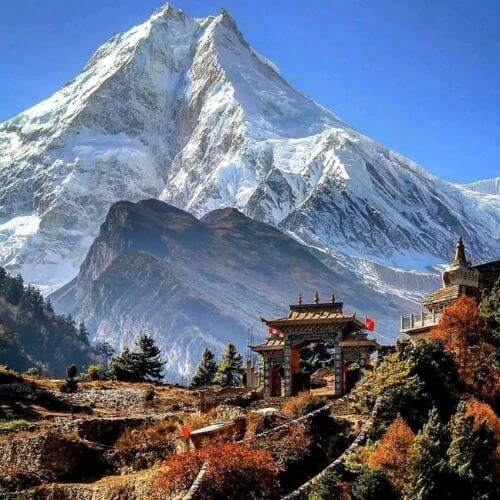Hike to Tigers Nest Monastery ( Paro Taktsang)
Tigers Nest Monastery, also known as Paro Taktsang, is one of the top 10 places to visit in Bhutan. It is located on a cliff at about 3,000 meters above sea level, overlooking the Paro Valley. The monastery is built on the side of the mountain, offering stunning scenery of the area. The name "Tigers Nest" comes from a legend that says that Guru Rinpoche, a well-known Buddhist saint, flew to the site on a tiger and meditated there in the 8th century.
To reach the monastery, one has to ascend a steep mountain path. The ascent is challenging but not very difficult, and it takes 2 to 3 hours to reach the top. The way is surrounded by pine trees, and you may notice waterfalls along the hike. Once you reach the monastery, you can view excellent views of the valley below. There are four principal temples in the monastery and a few small rooms in which monks reside and meditate. It is a sacred site for Buddhists to visit, and many individuals visit to pay homage and meditate and is a Bhutan must-visit place.

What to Expect?
- You’ll see amazing views of the valley and mountains.
- The hike is hard, but the destination makes it worth the effort.
- The monastery is built on a cliff, making it look incredible.
- The monastery feels calm and peaceful when you enter.
- It’s an important Buddhist place built in the 1600s.
Explore Thimphu - Bhutan's Capital
Thimphu is the capital and also the largest city in Bhutan. It is located along the valley of the Wang Chhu river. It is a city where traditional Bhutanese culture blends with modern development. Ancient temples stand along government buildings, and one of the most important landmarks is Tashichho Dzong huge fortress monastery that contains government offices and the throne room.
Thimphu is unique for not having any traffic lights. Instead, police direct the traffic by hand, and this has been a tourist attraction. The famous Weekend Market also lies in the city, where people sell fresh produce and handicrafts. The National Memorial Chorten is another important site where locals gather to pray. Despite growing fast, Thimphu remains small, with about 115,000 people. All buildings follow the traditional Bhutanese designs and add to the unique character of the city. This city is the most beautiful in Bhutan, and exploring Thimphi is the best thing to do in bhutan with kids.

Top Attractions in Thimphu
- Tashichho Dzong - A fortress monastery housing government offices and the king’s throne room.
- National Memorial Chorten - A white stupa with golden spires where locals pray and perform religious rituals.
- Weekend Market – Busy market selling fresh produce, handicrafts, and local goods.
- Folk Heritage Museum - A traditional Bhutanese house showcasing the country’s rural lifestyle and culture.
- Textile Museum - Displays Bhutan’s beautiful handwoven fabrics and traditional clothing.
- Motithang Takin Preserve - A wildlife sanctuary home to the Takin, Bhutan’s national animal.
- Changangkha Lhakhang - An ancient temple where parents bring their newborns for blessings.
- Royal Botanical Garden - A peaceful garden with beautiful flowers and hiking trails.
Visit Punakha Dzong
Punakha Dzong is among the most beautiful places in bhutan and historically significant structures in Bhutan. Situated at the confluence of the Pho and Mo rivers, it is famous for its breathtaking architecture and picturesque location. The dzong was constructed in 1637 by Shabdrung Ngawang Namgyal, the first spiritual and temporal ruler of Bhutan. It was the capital of the country until 1955 and continues to be a major religious hub.
The dzong is often called the "Palace of Great Happiness" because of its peaceful and beautiful location. It is an impressive structure with large courtyards, intricate woodwork, and golden rooftops. The Punakha Dzong is also famous for its large prayer halls and temples, which house sacred relics, including the remains of Shabdrung Ngawang Namgyal. The Punakha Dzong plays a key role in Bhutanese religious life. It is the site of many important religious ceremonies, including the annual Punakha Tshechu (festival), where monks perform traditional dances. The dzong is also the official residence of the Chief Abbot of Bhutan. Punakha Dzong is among Bhutan's most frequented sites in Bhutan. Its beauty, cultural, historical, and religious value make it a place that should not be missed by anyone visiting Bhutan.

Major Highlights of Punakha Dzong
- Built-in 1637 by Shabdrung Ngawang Namgyal, it is one of the oldest and most important dzongs in Bhutan.
- The dzong features beautiful woodwork, large courtyards, and golden rooftops.
- It is home to many sacred relics, including the remains of Shabdrung Ngawang Namgyal.
- The Punakha Tshechu, a major religious festival, is held here each year with colorful mask dances and ceremonies.
- It is the official residence of Bhutan’s Chief Abbot.
- The dzong is surrounded by lush greenery, tall trees, and breathtaking views of the mountains.
Cross the Longest Suspension Bridge in Bhutan
The Punakha Suspension Bridge is one of the longest suspension bridges in Bhutan and also one of the most beautiful in the country. It connects the historic town of Punakha, once the capital of Bhutan. It measures about 160 meters in length and offers great views of the river, the mountain ranges, and the lush green valleys across it. It is made of iron chains and steel cables, making it strong and stable. Though it is very high, being above the river, it does not threaten the lives of people crossing it. This bridge is utilized daily by many tourists and natives who travel to and from their villages and Punakha town.
Equally, the Punakha Suspension Bridge is decorated with colored prayer flags that again hold an important place in Bhutanese culture. These are inscribed with prayers and mantras, and hence the belief is that the wind carries away these prayers and brings good fortune with it.
The suspension bridge is among the most favored places for travelers and photographers. This is a very good place for taking pictures, enjoying fresh air, and appreciating the natural beauty of Bhutan. Many visitors stop by after exploring Punakha Dzong or take short hikes in the surrounding hills.

What to Expect?
- The bridge may sway slightly as you walk, especially when it's windy or crowded.
- Expect cool and fresh air, especially in the morning and evening.
- Walking across the high bridge can feel exciting, especially for first-timers.
- The surroundings are quiet and serene, making it a great place to relax.
- You might see monks, villagers, and traders using the bridge as part of their daily routine.
- There is no charge to visit and walk on the bridge.
Enjoy the Paro Festival (Tshechu)
The Paro Festival, or Paro Tshechu, is one of Bhutan’s most important religious and cultural events. It takes place every year in Paro, usually in March or April, to honor Guru Rinpoche (Padmasambhava), who introduced Buddhism to Bhutan. It is the most popular tourist attraction in Bhutan.
During this festival, the people of Bhutan and many tourists come together and enjoy the vibrant colors of the festivities. The prime events are held at Paro Dzong, a large fortress-monastery, by monks who perform sacred mask dances. These mask dances are not performed merely for the sake of entertainment but are steeped in deep spiritual meaning. The dancers are gorgeously masked and costumed, representing gods, demons, and figures from Bhutanese legends.
A major highlight of the festival happens on the last day, early in the morning, when a huge religious painting called a thongdrel is displayed. This sacred artwork is so large it covers an entire building. People believe that just seeing the thongdrel can cleanse their sins. It is shown only for a few hours before sunrise to protect it from sunlight, and many wake up early to witness this rare event.

Best Time to Visit
The best time to visit Bhutan to experience the Paro festival is usually between late March and early April. The festival takes place on the 10th day of the second lunar month of the Bhutanese calendar.
Visit Bumthang - The Switzerland of Bhutan
Bumthang is a region in central Bhutan, often called the "Switzerland of Bhutan" mainly because of its green valleys, rolling hills, and peaceful atmosphere. It is one of the most scenic and culturally rich areas in the country, making it a popular tourist attraction in Bhutan. Bumthang consists of four main valleys—Chokhor, Tang, Ura, and Chhume—each offering stunning landscapes, ancient temples, and traditional Bhutanese villages.
People come to visit Bumthang mainly because it is deeply connected with Bhutanese history and religion. It contains some of the oldest, holiest monasteries in Bhutan, among them Jambay Lhakhang and Kurjey Lhakhang, which are associated with Guru Rinpoche founder of Buddhism in Bhutan. Most religious festivals, or tshechus, are held here; they attract locals and tourists alike.
Bumthang is indeed renowned for agricultural produce and delicacies. It produces buckwheat of fine quality, red rice, potatoes, and apples. It is particularly known for its honey, cheese, and Red Panda beer, which is brewed at the famous Red Panda Brewery, one of the first commercial breweries in Bhutan. Exploring Bumannag is a popular thing to do in Bhutan at night.

Top Places to Explore in Bumthang
- Jambay Lhakhang- One of the oldest temples in Bhutan, built in the 7th century by King Songtsen Gampo making it a Bhutan must-visit place.
- Kurjey Lhakhang- one of the most revered temples in Bhutan. It is dedicated to Guru Rinpoche
- Punakha Dzong- This is a stunning fortress that holds great religious and historical significance and is considered one of the most beautiful dzongs in Bhutan.
- Ura Valley- Ura is the highest valley in Bumthang and is known for its beautiful landscapes and traditional houses. It’s an excellent spot for hiking.
- Tang Valley- A beautiful valley known for its remote monasteries, It is also home to the famous Mebar Tsho (Burning Lake), which is a significant pilgrimage site for Bhutanese Buddhists.
Visit the Buddha Dordenma Statue
Buddha Dordenma Statue is a gigantic Buddha statue located in Thimphu, the capital of Bhutan. It is also one of the largest Buddha statues in the world, at 51.5 meters (169 feet) in height. It is of bronze and gilded in gold. It sits on a huge throne, itself a special monument, overlooking the entire Thimphu Valley.
The statue is that of the future Buddha, or Metteya or Metteya Buddha. It is believed that this Buddha will bring happiness and peace to the world. The Buddha Dordenma has been constructed aiming at spreading peace, spirituality, and unity within Bhutan. It is also believed that the statue follows a prophecy given by a well-known Buddhist teacher called Guru Rinpoche, or Padmasambhava, in the 8th century; he had told people that in this area, a statue like this would be built.
The statue was completed and opened in 2017, but its construction had begun earlier. It is built on a hill named Kuenselphodrang in Thimphu. It is one of the popular places to visit in Thimphu. The statue is in a very big complex that includes meditation halls and shrines. There are 125,000 small Buddha statues inside the statue. Getting inside this statue is among the fun things to do in Bhutan. This makes it a very religious and sacred site for Buddhists. A person can go to the statue, pray, and meditate in the peaceful surroundings of the statue.

What to Expect?
- A tall, golden Buddha statue.
- Beautiful views of Thimphu Valley and mountains.
- Thousands of smaller Buddha statues are inside.
- Quiet places for meditation and reflection.
- A place where people pray and light incense
Explore Trongsa Dzong- The largest fortress in Bhutan
Trongsa Dzong is an incredibly beautiful and historic fortress located in the central part of Bhutan, in the town of Trongsa. This is the largest and one of the most important dzongs in Bhutan, rich in history. Initially, it was built in 1644 and became an administrative and religious center of strategic importance. It faces the valley of the Mangde River, offering stunning views of the surrounding mountains.
The dzong is famous for its architectural brilliance, having high walls and richly ornate wooden carvings. It contains many courtyards, temples, and rooms used for both religious and administrative purposes. Trongsa Dzong has also been a place where many of Bhutan's kings were trained and has played a key role in the country's history and development.
Besides being of historic importance, it is also representative of the solid traditions and customs of Bhutan. Visitors can explore the large grounds of Trongsa Dzong and the traditional Bhutanese architectural style, making it one of the unique things to do in Bhutan.

What to Expect?
- It was built in 1644 and is one of the largest and most beautiful dzongs in Bhutan.
- It is located on a hilltop, which provides a breathtaking view of the surrounding valleys and mountains.
- Historically it was the seat of power for the Wangchuck dynasty prior to moving to Thimphu.
- Visitors can expect a magnificent structure with large courtyards, intricate wood carvings, and colorful paintings, showcasing traditional Bhutanese architecture.
- It houses several important Buddhist temples and shrines, hence serving as a spiritual hub for the locals.
Drive Chele La Pass- Bhutan's highest road pass
Chele La Pass is a popular mountain pass, located at an altitude of about 3,988 meters (13,083 feet) above sea level. It is one of the highest motorable passes in Bhutan, offering stunning views of the Himalayan mountain range, including peaks like Jhomolhari and Jichu Drake. The pass is located on the road between Paro and Haa Valley, making it a key spot for travelers heading to these regions.
The journey to Chele La Pass is scenic, with roads passing through forests of pine and rhododendron trees. The area is known for its peaceful atmosphere and natural beauty, with clear blue skies and fresh mountain air. During spring, the rhododendron flowers bloom, adding to the serenity.
Chele La Pass is also a popular spot for hiking and is among the most unique things to do in Bhutan. Visitors can trek to nearby areas, including the Kila Goemba, a small Buddhist nunnery located on the slopes of the pass. The pass is considered sacred, and many people visit to pray or meditate in the serene environment.
What to Expect?
- Offers panoramic views of the Himalayan mountain range, including peaks like Jhomolhari and Jichu Drake.
- In spring, the rhododendron flowers bloom, adding vibrant colors to the landscape.
- Popular for hiking, with trails leading to nearby areas like Kila Goemba, a Buddhist nunnery.
Visit Dochula Pass- A mountain pass with 108 white temples
Dochula Pass is a popular tourist attraction in Bhutan, located at an elevation of around 3,100 meters (10,171 feet) above sea level. It is situated along the Punakha Highway, about 30 kilometers (19 miles) from Thimphu, the capital of Bhutan. The pass offers stunning views of the Himalayan mountain range, especially on clear days, with peaks like Gangkar Puensum, the highest mountain in Bhutan.
Dochula Pass is primarily known for 108 chortens or the Dochula Druk Wangyal Chortens. Visiting this 108 temple is the best thing to do in Bhutan. These were built by the Queen Mother, Ashi Dorji Wangmo Wangchuck, in memory of Bhutanese soldiers who lost their lives in a military operation in 2003. These are arranged in a circular pattern and give the location a spiritual and cultural touch.In addition to the chortens, there is a beautiful temple at the pass called Druk Wangyal Lhakhang, which was built to commemorate the 100th anniversary of the Bhutanese monarchy. It is also one of the most favorite stops for tourists to take pictures and to enjoy cool fresh mountain air. It is also very famous, especially in winter when it usually gets all covered in snow, hence looking very pretty.

What to Expect?
- The Dochula Druk Wangyal Chortens are impressive and have a deep cultural and spiritual significance.
- Enjoy easy treks like the Dochula Nature Trail through beautiful forests, with a chance to spot wildlife and birds.
- The high altitude provides refreshing, cool air, perfect for a peaceful stop during your travels.
- In winter, the pass is often covered in snow, creating a beautiful, serene atmosphere.
Conclusion
The top 10 places to visit in Bhutan are perfect for travelers looking for an unforgettable adventure in this peaceful Himalayan country. Bhutan is known for its mix of beautiful nature and rich culture. From holy monasteries on mountain cliffs to quiet valleys with colorful prayer flags, Bhutan offers an experience that is both real and life-changing. The country cares deeply about keeping its traditions alive while also growing in a way that’s good for the environment. It’s a great place for anyone wanting both excitement and peace for the soul.
Frequently Asked Questions
Can I travel independently in Bhutan?
No, Bhutan has a unique tourism system. You need to book a tour through a licensed travel agency. Solo travel is not allowed, but you can choose your own travel dates, activities, and experiences with a guide.
How fit do I need to be to visit Tigers Nest Monastery?
You need to be in good health and have a basic level of fitness. The hike to Tiger’s Nest Monastery is about 4-6 hours and includes steep paths. If you're active and can walk uphill for a few hours, you should be fine.
What is the famous thing about Bhutan?
Bhutan is famous for its Tiger's Nest Monastery, stunning Himalayan landscapes, and being the first country to measure its success with Gross National Happiness rather than just economic growth.
What is the specialty in Bhutan?
Bhutan is famous for its rich culture, beautiful Buddhist monasteries, and traditional arts in painting, weaving, and wood carving. Also, it is famous for its Himalayan environment and unique festivals.
What kind of food should I try in Bhutan?
Try Ema Datshi, the most famous chili and cheese dish in Bhutan. Other recommendations include Phaksha Paa, consisting of pork and radish; Momos is Bhutan's version of dumplings, and Suja, a type of butter tea.



 based on 3 reviews
based on 3 reviews











